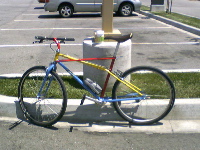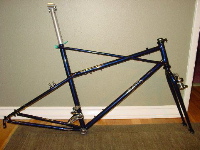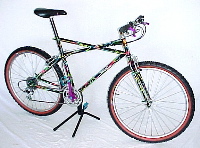

This is the bare-bones start of something I've wanted to do for a long time - provide a registry of bikes built/designed by Richard Cunningham while he was building as Mantis, with a specific focus on the Valkyrie/X-Frame in its original, pre-elevated chainstay model. Why so specific? Because this frame was the frame I dreamed of owning in my early mountain bike years. I remember seeing a few around, here and there, while riding as a kid in SoCal, and seeing pictures of the garish every-tube-a-different-color team bikes in the rags of the day, and knew that I had to have one. I still feel the same way - and I still don't have one. So this is how I compensate.
Richard Cunningham got his start in the bike business wrenching in a shop after years working on cars and motorcycles, and eventually moved up to working at Medici. After seeing his first mountain bikes, he started Mantis in 1981, and began building steel frames to the general period spec - fairly relaxed angles, long chainstays, what we now refer to as "touring" geometry, though it wouldn't have been called that then, before the evolution of what became known as "racing" geometry. The first named model was the Sherpa, a fillet-brazed steel frame. Mark Grayson partnered in the business in the early years, welded most of the TIGed Overlands, and left just about the time the XCR came about in 1983 (To go on working with Brave and Mountain Cycle, among others). The XCR was really a pivotal point in the development of the company, and also a step towards racier bikes and the design philosophy of laterally/torsionally stiff main frames with compliant front and rear ends - it became a legendary frame in its own right. The heavily triangulated main from of the X-frame/Valkyrie continued what the oversized aluminum main triangle of the XCR started, as did the development of elevated chainstays (though perhaps too much emphasis was placed, at the time, on their elimination of "chain suck" and mud clearance issues, which really weren't big issues in this writer's opinion, if you were a smooth shifter using short cage derailleurs with strong return springs, or had a properly designed frame :) ), which led to the Valkyrie-EC and XCR-EC, and eventually the Flying V, which took design elements from the XCR-EC, and mated them to a monocoque front "triangle" for an even stiffer main frame.
Mantis was an obvious company to head into the suspension market, in hindsight - RC took great pains to preserve the "feel" of curved fork blades in his straight blade forks, tapering the wall thickness towards the tips to allow them to flex in the same manner, eliminating a lot of the harshness that accompanied the advent of straight-blade unicrown forks on mountain bikes, while preserving their attractiveness in terms of ease and cost of construction (compared to other straight-blade rigid fork solutions to this issue such as the Koski-type, Bontrager and IRD forks). Between this and the focus on trying to pair a stiff main triangle with a more compliant rear triangle, suspension was really the logical extension of his existing rigid frame designs. Suspension-corrected geometry began to appear (when?), and eventually, along came the ProFloater, which, while looking like a fairly conventional AMP-style rear end that many a manufacturer was using, apparently has something else going for it, considering its considerable fan base even now, in the face of vastly more advanced suspension designs. Finally, after the sale of the company, Mantis partnered with GT to release the Screaming V, one of the early thermoplastic frames, which, despite this construction method falling out of favor on weight terms (as compared to other forms of carbon fiber), definitely had some engineering advantages where durability and fabrication are concerned.
Serial numbers for most Mantis frames follow a fairly simple pattern. The steel frames typically have a first letter (or letters) indicating the model, followed by a 2 digit number indicating the frame size, and finished with a sequential number - so VK1911, for instance, would be the 11th 19" Valkyrie made. Aluminum frames (including the XCR) were numbered similarly, but with an additional number indicating which batch of frames they were heat-treated in. By this scheme, X19217 would be the 17th 19" XCR heat-treated in batch 2. This pattern most likely changed with the introduction of the XCR-EC and higher sequential heat-treating batch numbers, and eventually the order of the heat-treatment batch number and the sequential frame number were switched, so that, say, VL18427, refers to the 4th 18" long Flying V heat-treated in batch 27. The heat-treatment batch number was added for quality control purposes, and any given batch could contain several different frame types (batch 27, for instance, also contained Flying V #VL183327, and ProFloater # S21127, among others). Non-sequential and otherwise oddball serial numbers indicate team bikes, prototypes, or other special bikes. I beleive this pattern holds up until the sale of the company.
Anyhow, if you own a Mantis of any description, or have anything to add, correct or contribute, please email me with its serial #, pictures, and any info you care to send about it, to create a gallery devoted to these unique frame designs. I'm also interested in high-resolution scans of any Mantis catalogues or other promotional material, and of magazine articles related to their production, to add to the resource available here.
For me, this was always THE Mantis frame, and thus, I've given it top billing (the remaining Mantis production is linked below in chronological order). It stood out because of its unique design, and the race bikes of the Mantis team in the mid/late 80s stood out even more because of their multicolor paint jobs. Built from 1985-86 or so into the early 90s, in the later years as an elevated chainstay design (see Valkyrie-EC/FS link below). Initially, i beleive these standard chainstay frames were just referred to as X-Frames, but later gained the name Valkyrie. All versions are notable for their unfiled fillet brazing, which made the continuance of the model post-sale simply infeasible - there just weren't the people out there with the skills to build it.
MBA Aug 1987
| picture, serial # | description |
 JIMSXFRAME |
18"
1989 |
 VK202 |
20" |
 PATSX20 |
20"
1989 |
The Mantis thread at mtbr.com, source of a good bit of the initial material for this page
Mantis page at First Flight Bikes
A HUGE thank you to Shayne Santi for information and setting me down the right path on the later (post-e-stay) production, which I'm not as familiar with, and another HUGE thanks to RC himself, for confirming what I'd heard concerning the serial # scheme, adding details here and there - and for producing these bikes to begin with!